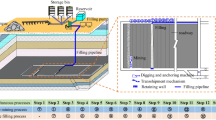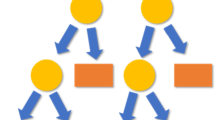Abstract
As a main strategy of backfilling in mining operations, cemented rockfill (CRF) is extensively used because of its high strength and mine waste disposal convenience. The CRF strength has a direct bearing on ground support performance in backfill mining, which necessitates investigating CRF strength determination. This study employed a Gaussian process (GP) machine learning model to reflect the relationship between CRF compressive strength and material components as well as curing age. More than one thousand data from a public database were used to train the GP model with an automatic hyperparameter optimization. A series of laboratory tests prepared eight test samples for our predicting as well as the true values for model validation. The GP model achieved a predicting accuracy with the r2 value 0.90 and the MSE value 7.78 based on CRF true values we obtained in the laboratory. In addition, seven test samples’ true values resided inside the 95% confidence interval of the GP prediction. We also constructed three other machine learning models to conduct the same work as the GP model did. The results showed that the GP model performed the best of four models, which demonstrated that the GP model was effective and robust in dealing with time series predicting task.






Similar content being viewed by others
References
Reschke A (1993) The use of cemented rockfill at Namew Lake mine, Manitoba, Canada. In: Minefill, pp 101–108
Shrestha BK, Tannant DD, Proskin S, Reinson J, Greer S (2008) Properties of cemented rockfill used in an open pit mine. In: GeoEdmonton’08. The Canadian geotechnical society edmonton, pp 609–616
Mitchell R, Roettger J (1989) Analysis and modelling of sill pillars. In: Innovations in mining backfill technology Balkema, Rotterdam, pp 53–62
Emad MZ (2013) Dynamic performance of cemented rockfill under blast-induced vibrations. Ph.D. dissertation, McGill University, Montreal, Quebec, Canada
Emad MZ, Mitri HS, Henning JG (2012) Effect of blast vibrations on the stability of cemented rockfill. Int J Min Reclam Environ 26(3):233–243
Mehta PK, Monteiro PJM (1986) Concrete: Structure, properties and materials. Prentice Hall, Upper Saddle River, New Jersey
Committee A Building code requirements for structural concrete: (ACI 318-99); and commentary (ACI 318R-99). In: 1999. American Concrete Institute
Yeh I-C (1998) Modeling of strength of high-performance concrete using artificial neural networks. Cem Concr Res 28(12):1797–1808
Öztaş A, Pala M, Ea Özbay, Kanca E, Caglar N, Bhatti MA (2006) Predicting the compressive strength and slump of high strength concrete using neural network. Constr Build Mater 20(9):769–775
Lai S, Serra M (1997) Concrete strength prediction by means of neural network. Constr Build Mater 11(2):93–98
Atici U (2011) Prediction of the strength of mineral admixture concrete using multivariable regression analysis and an artificial neural network. Expert Syst Appl 38(8):9609–9618
Yan K, Shi C (2010) Prediction of elastic modulus of normal and high strength concrete by support vector machine. Constr Build Mater 24(8):1479–1485
Shahin MA, Jaksa MB, Maier HR (2001) Artificial neural network applications in geotechnical engineering. Austr Geomech 36(1):49–62
Karlin S (2014) A first course in stochastic processes. Academic Press, Cambridge
Rasmussen CE (2003) Gaussian processes in machine learning. In: Summer School on Machine Learning. Springer, Berlin, Heidelberg, pp 63–71
Xu C, Torres-Verdín C (2013) Pore system characterization and petrophysical rock classification using a bimodal Gaussian density function. Math Geosci 45(6):753–771
Esfahani NM, Asghari O (2013) Fault detection in 3D by sequential Gaussian simulation of Rock Quality Designation (RQD). Arab J Geosci 6(10):3737–3747
Von Mises R (2014) Mathematical theory of probability and statistics. Academic Press, Cambridge
Ebden M (2008) Gaussian processes for regression: a quick introduction. the website of robotics research group in department on engineering science. University of Oxford, Oxford
C192, C192M A (2007) Standard practice for making and curing concrete test specimens in the laboratory. ASTM International, West Conshohocken
Lingga BA (2018) Investigation of cemented rockfill properties used at a Canadian diamond mine. University of Alberta, Edmonton
C496 (2011) Standard test method for splitting tensile strength of cylindrical concrete. ASTM International, West Conshohocken
Pedregosa F, Varoquaux G, Gramfort A, Michel V, Thirion B, Grisel O, Blondel M, Prettenhofer P, Weiss R, Dubourg V (2011) Scikit-learn: machine learning in Python. J Mach Learn Res 12:2825–2830
Acknowledgements
This study was supported by the Natural Sciences and Engineering Research Council of Canada (NSERC) under Collaborative Research and Development (CRD) Grant, and also, supports from the Chinese Scholarship Council were gratefully acknowledged.
Author information
Authors and Affiliations
Corresponding authors
Additional information
Publisher's Note
Springer Nature remains neutral with regard to jurisdictional claims in published maps and institutional affiliations.
Rights and permissions
About this article
Cite this article
Pu, Y., Apel, D.B., Chen, J. et al. A Gaussian process machine learning model for cemented rockfill strength prediction at a diamond mine. Neural Comput & Applic 32, 9929–9937 (2020). https://doi.org/10.1007/s00521-019-04517-x
Received:
Accepted:
Published:
Issue Date:
DOI: https://doi.org/10.1007/s00521-019-04517-x




